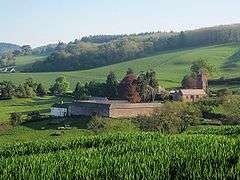Dunchideock
Dunchideock (/ˈdʌntʃɪdək/ DUN-chi-dək, /dʌnˈtʃɪdiək/ dun-CHID-ee-ək) is a small civil parish on the north eastern slopes of the Haldon Hills in Teignbridge, Devon, England. It covers an area of 392 hectares (970 acres)[1] and lies about 6 km (3.7 mi) south-west of Exeter and 11 km (6.8 mi) north-east of Bovey Tracey. The parish, with a population of 262 in 2001, lacks a compact village, but consists of scattered dwellings.[2]
| Dunchideock | |
|---|---|
 A view over part of Dunchideock. The church is on the right with Dunchideock farm in front. Haldon Belvedere is on the skyline to the left. | |
 Dunchideock Location within Devon | |
| Population | 262 (2001 UK Census) |
| OS grid reference | SX8887 |
| District | |
| Shire county | |
| Region | |
| Country | England |
| Sovereign state | United Kingdom |
| Post town | EXETER |
| Postcode district | EX2, EX6 |
| Dialling code | 01626 |
| Police | Devon and Cornwall |
| Fire | Devon and Somerset |
| Ambulance | South Western |
| UK Parliament | |
The name Dunchideock is of Celtic origin. Recorded in Domesday as Donsedoc, the two parts of the name derive from dun (fort) and coediog (wooded),[3] which, according to W. G. Hoskins, refer to the nearby Iron Age hill fort of Cotley Castle,[4] though the Roman fort at grid reference SX885889, near Ide, is closer.
The parish church is dedicated to St Michael and is Grade I listed.[5] It originated in 1308 at the latest, but the present church building, built of red sandstone, was started in the late 14th century. It has been partially rebuilt and restored many times.[2] There is a good font dated to around 1400, some notable carved bench-ends, roof-bosses and rood-screen; and several memorials, most notably to Aaron Baker, who rebuilt the chancel aisle in 1669, and Stringer Lawrence.[4] The theological writer Bourchier Wrey Savile was rector of Dunchideock with Shillingford St. George from 1872 to his death in 1888.[6]
Within the parish was the former Haldon House which was the home of Sir Robert Palk, 1st Baronet. Mostly demolished in the 1920s, the remaining wing is now the Best Western "Lord Haldon Hotel". Also in the parish is Haldon Belvedere, a triangular tower on top of Haldon that was built by Palk in 1788 in memory of his friend General Stringer Lawrence.[7]
Archie Winckworth, the former owner of Dunchideock House, posted a memoir about the village and its history, including an account of its buried treasure.[8] The cellars of Dunchideock House are fancifully supposed to contain a treacle mine.[9]
References
- "A Brief Outline of the Parish". Dunchideock Parish. Archived from the original on 7 June 2010. Retrieved 20 July 2009.
- Harris, Helen (2004). A Handbook of Devon Parishes. Tiverton: Halsgrove. pp. 62–63. ISBN 1-84114-314-6.
- Gover, J.E.B., Mawer, A. & Stenton, F.M (1931). The Place-Names of Devon. English Place-Name Society. Vol viii. Part II. Cambridge University Press. p. 495.CS1 maint: multiple names: authors list (link)
- Hoskins, W. G. (1972). A New Survey of England: Devon (New ed.). London: Collins. pp. 390–391. ISBN 0-7153-5577-5.
- Historic England. "Church of St Michael, Biddypark Lane, Dunchideock (1334285)". National Heritage List for England. Retrieved 21 July 2009.
- "A Cambridge Alumni Database". University of Cambridge. Retrieved 21 July 2009.
- "Haldon Belvedere (Lawrence Castle) - Brief History". Dunchideock Parish. Archived from the original on 15 August 2011. Retrieved 20 July 2009.
- Winckworth, A. N. "GENUKI/Devon: Memories of Dunchideock". genuki.cs.ncl.ac.uk. Retrieved 20 July 2009.
- Barber, Chips (1982). Around & About the Haldon Hills. Obelisk Publications. pp. 95–97. ISBN 0-946651-14-0.
External links
![]()